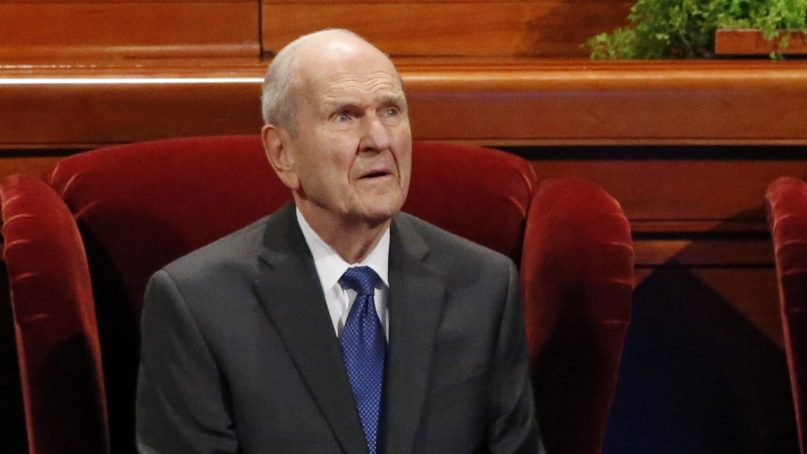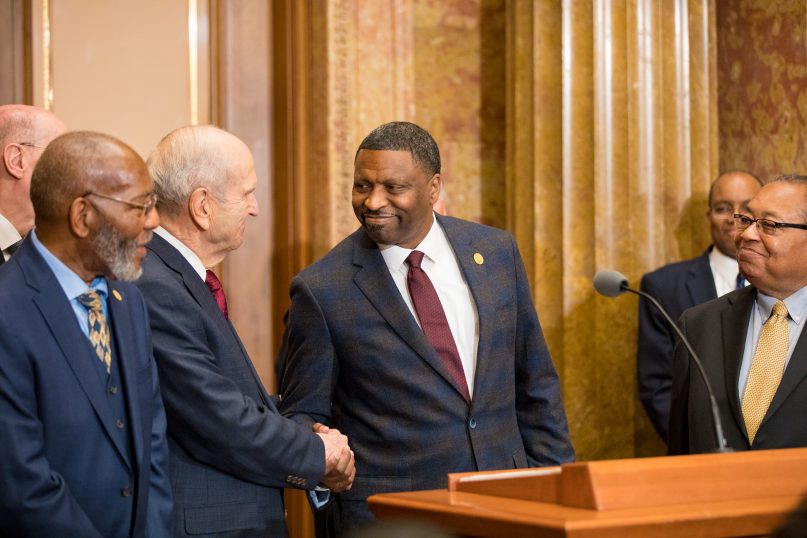(RNS) — Russell M. Nelson, president of the Church of Jesus Christ of Latter-day Saints, will address the annual meeting of the NAACP on Sunday, the latest sign of rapprochement between Mormon leaders and the nation’s historic advocacy organization for African Americans.
Since Nelson took office in January of 2018, Latter-day Saints have joined with the NAACP in several appearances to promote racial equality and put an end to prejudice of all kinds. Notably, the church is drawing upon its own commitment to individual self-reliance by partnering with the NAACP to offer free courses in personal finance and business in four U.S. cities.
It’s my guess that we’ll hear Nelson speak about this program at the convention or possibly present other joint ventures that have yet to be announced. I would be surprised if he openly discusses the elephant in the room: the church’s own past discrimination toward people of African descent.
It’s not a history of which church members should be proud. The mission of the NAACP, founded in 1909, is “to secure the political, educational, social, and economic equality of rights in order to eliminate race-based discrimination and ensure the health and well-being of all persons.”
That is not a mission the LDS church has always supported.
In 1908, according to historians Matthew Harris and Newell Bringhurst, the church’s First Presidency and Quorum of the Twelve instructed missionaries not to “take the initiative in proselyting among the Negro people … or people tainted with Negro blood.”

President Russell M. Nelson looks on during the morning session of a twice-annual conference of The Church of Jesus Christ of Latter-day Saints Saturday, March 31, 2018, in Salt Lake City. (AP Photo/Rick Bowmer)
A century ago such a policy was, unfortunately, not terribly unusual in America. What was unusual was how long, and how vigorously, the LDS church clung to and defended its ongoing racism. It did not ordain black men to the priesthood or allow black men and women to enter its temples until 1978, more than a decade after the civil rights era had begun.
That’s not to say that the church was always and consistently on the wrong side of justice. One of the most interesting aspects of Harris and Bringhurst’s work (and of Harris’ recent book, “Thunder from the Right,” about the eventual LDS president and Eisenhower cabinet member Ezra Taft Benson) is to show the heated debates that took place in the Quorum of the Twelve in the 1960s about race — not just about the church’s internal priesthood/temple ban, but about whether and how the church should take a position on civil rights concerning employment, housing, and integration.
The fact that the church did finally take a stand in 1963 in favor of some civil rights for African Americans was largely due to the NAACP’s prodding. Utah was at that time the only western state that had not passed legislation guaranteeing basic rights for minorities, and the NAACP was not having it. The organization threatened to publicly protest the church’s October 1963 General Conference if the church did not issue some kind of statement expressing its support for fair housing, educational opportunity, and employment. Apostle Hugh Brown, who had long advocated in the Quorum for the church to do precisely this, seized the opportunity and, with then-President David McKay’s permission, read such a statement in the October Conference.
But that step forward didn’t stop Benson, also an apostle, from publicly opposing Martin Luther King Jr., connecting the civil rights movement to communism or supporting segregationist politicians like Alabama Governor George Wallace.
Nor did it stop Apostle Bruce R. McConkie from preserving disturbing racist language about “the Negro,” “Cain” and “Ham” from his wildly popular book “Mormon Doctrine.” Revised in 1979 with its racist language intact, it remained on the shelves at the church’s Deseret Book bookstores until 2010.
And despite the 1963 statement, the church didn’t end the priesthood/temple ban for another 15 years. In this decade, though, remnants of the old justifications behind the ban live on: in February 2012, for example, The Washington Post interviewed a BYU religion professor who suggested that the ban was appropriate because people with black skin were not ready for the responsibility of priesthood before 1978. (That same week, not coincidentally, the church did damage control with a Newsroom statement that clarified that “all are alike unto God” and that the church “unequivocally condemns racism.”)
So yes, there is a lot for which a Mormon president could apologize to the NAACP. But will he?
I suppose it’s possible, but such a move would be at odds with the church’s entrenched recent history of not admitting to institutional mistakes, because that would involve criticizing the decisions of previous presidents whom the faithful uphold as prophets of God.
On the other hand, Seattle church member Aaron Brown pointed out this week on Facebook that Nelson has not been afraid to overturn other precedents established by Latter-day Saint leaders:
“If President Nelson can seemingly throw his predecessors under the bus for failing to eschew use of the term ‘Mormon’ (of all things), surely he can throw even more of them under it for perpetuating a noxious racial policy for 100+ years and wrongly attributing it to deity. And what a perfect forum in which to make the announcement! Please, God, make it so.”
In recent years, the church has tried to promote the idea that all of this attention to race is ancient history and that our task as a people is simply to move onward, ever onward. Full speed ahead!
I see two problems with this approach.
First, it’s a live question whether Mormon racism is, in fact, ancient history (see here for more on current racial attitudes). Some of these attitudes persist today.
And second, it’s an exercise of white privilege to take the “move along, nothing to see here, folks” line without actually listening to people’s pain. Latter-day Saint racism has caused deep wounds in society at large and in the hearts of black church members in particular; it almost seems like the church is asking people to forget that ever happened and focus blithely on the future.
One lesson we learned from Desmond Tutu’s Truth and Reconciliation Commission in South Africa is this: we don’t get to skip to the “reconciliation” part until we’ve waded through the even harder “truth” part.
Let’s hope there will be both truth and an olive branch in President Nelson’s remarks this weekend.
Related posts:
- “Stranger Things” sees Mormons as “super-religious white people”
- Fake Mormon news story goes viral, claiming LDS Church has apologized for racism
- Is race really “trivial” and “temporary” in Mormonism?
- Black Mormon pioneer Jane Manning James finally gets her due






